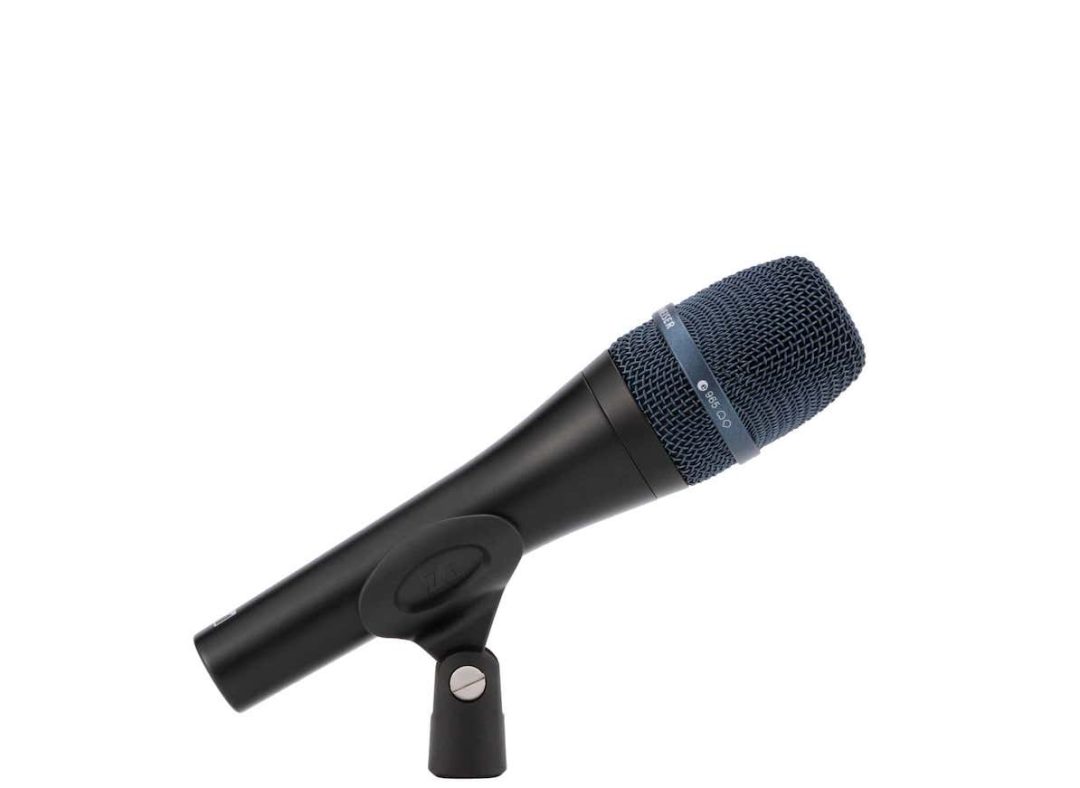In today’s review, we’ll cover the Sennheiser e965 handheld microphone — a tough and dependable mic designed to bring the clarity of condensers to live performance.
The Sennheiser Evolution 900 Series Was Built to Dominate Live Sound
Sennheiser has consistently delivered uncompromising sound quality and dependability to the studio and stage for decades. The Evolution 900 series is a complete lineup of microphones for a variety of instruments and applications for live sound reinforcement. Each mic is designed to bring out the best from performers and give live sound engineers trustworthy and reliable sources of reproduction.
What Mics Make Up the Evolution 900 Series?
- e935: dynamic vocal microphone
- e945: dynamic lead vocal microphone
- e901: half-cardioid boundary microphone for kick drum and piano
- e902: dynamic instrument microphone for kick drum and bass guitar
- e904: dynamic instrument microphone for drums (toms, etc.)
- e905: dynamic instrument microphone for snare drum
- e906: dynamic instrument microphone for guitar amps
- e908 D: condenser instrument microphone for drums and percussion
- e908 B: condenser instrument microphone for brass
- e914: condenser instrument microphone for acoustic instruments, overhead, piano, and more
Click here for a closer look at the Evolution 900 lineup.
Sennheiser e965 Handheld Microphone Review
Impressions Out of the Box
As a stage microphone, you want a mic like the e965 to feel sturdy. It, unfortunately, has to withstand inevitable drops, dings, bangs, and all of the bumps associated with live performance. And since it is a condenser microphone, we need even more reassurance that this is as tough as any dynamic handheld.
- RELATED: Sennheiser e835 vs. Shure SM58
- RELATED: 10 Best Dynamic Microphones for Any Budget
First impressions show that this is a premium quality microphone, as one would expect being handmade by Sennheiser in Germany. Externally, it has some weight to it and feels rock-solid. Internally, a capsule shockmount virtually eliminates handling noise and integrated moisture protection will keep it running for years to come.
Choose Between Pickup Patterns
In most cases, engineers would tell you dynamic mics are the better choice for live sound since they’re less sensitive than condensers. And in most cases, they’d be correct. However, condensers inevitably offer higher fidelity than dynamics, as increased sensitivity leads to better sounding results. The problem is that additional sensitivity makes stage condensers more prone to bleed and feedback.
Luckily, the e965 has switchable cardioid and supercardioid polar patterns, the latter of which provides greater rejection on a busy stage. This feature alone helps make the e965 a formidable handheld condenser for live performance.
The Clarity of a Condenser for Live Sound
We mentioned it above, and there’s no way around it: condensers simply sound phenomenal. The e965 boasts an impressive 40 Hz to 20,000 Hz frequency response, and combined with a low-cut filter and -10dB pad, you can get some seriously fantastic results from this stage condenser. Those extra tools help you cut out excess low-end from bleed or room ambience, and the pad prevents the mic from clipping even on loud vocalists.
Materials
Sennheiser builds each e965 to exacting specifications using quality components at every step, all backed by a 10-year warranty. There could potentially be some doubts for a mic at this price (more on that below), but Sennheiser has a track record of producing professional quality audio products. The e965 is no exception.
Price
The e965 currently retails for $449. That isn’t cheap, per se, but it isn’t completely out of line at all. For a microphone of this pedigree, it’s very reasonable given its features and how much it could improve the sound and clarity of live vocals. Large institutions/venues with big budgets should have no problem acquiring several for various needs, while smaller budgets can pick up one or two for their on-stage singers.
When Would I Use a Sennheiser e965?
It’s pretty simple. The Sennheiser e965 is a handheld condenser microphone optimized for vocals. Just because it’s handheld doesn’t mean it’s only for the stage, though, as you could easily use this in the studio as well. If you want the quality of a condenser microphone with the toughness of a dynamic microphone, this would be it.
Final Thoughts: The e965 Is a Worthy Addition to Any Live Rig
Having an e965 in the arsenal is a surefire way to bring out the best from a performing vocalist. Having the option to run supercardioid eliminates many of the headaches associated with using condensers on stage, as does the handy filter and pad. Given the option to immediately improve sound reproduction in a live rig, most engineers would never say no.
